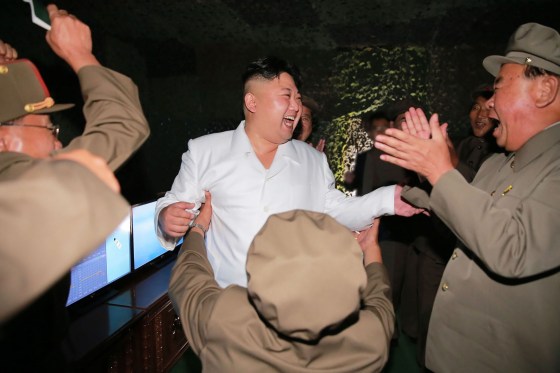North Korea marked its "Military First" holiday on Thursday with mass dancing, outdoor concerts and boasts of a successful submarine-launched ballistic missile test.
Television news broadcasts and the front pages of morning newspapers showed images of the launch, conducted early the previous day.
The test sent a "Pukguksong" missile soaring from a submerged position off the North's port city of Sinpo. It flew an estimated 310 miles toward the seas around Japan, the longest distance it has yet achieved in a submarine launch.
Kim was shown smiling and hugging officials after watching the test from an observation deck. He was quoted by state media as calling it the "success of all successes," though it brought immediate condemnation from the United States and the North's neighbors.

Launching long-range ballistic missiles from submarines is stealthier than land launching. Having that capability could significantly strengthen Pyongyang's ability to conduct strikes on U.S. positions in South Korea, and possibly on U.S. bases in Japan as well.
The North has attempted two such launches before, but neither was seen as successful by outside experts.
As the news of the missile test was broadcast on a large screen outside Pyongyang's main train station Thursday, dozens of people stood in the rain to watch.
North Korean state television on Thursday showed video clips of the launch of a missile from underwater at dawn, and still photographs of Kim on the dock at a port as a large crane unloaded an object onto a submarine.

"This shows that our national defense strength has reached a new level," said Choe Kum Chol, a 42-year-old factory worker. "We are a nuclear power and everything is ready, so we have nothing to fear."
North Korea has conducted a spate of military technology tests this year, including a fourth nuclear test in January and numerous ballistic missile launches, in defiance of U.N. Security Council sanctions that were tightened in March.
North Korea said this year it had miniaturized a nuclear warhead to fit on a ballistic missile. However, outside experts have said there is yet no firm evidence to back up that claim or show Kim's military had mastered the technology to bring a live warhead back into the atmosphere and guide it to strike a target.
The test came as the U.S. and South Korea are conducting their annual, 12-day Ulchi Freedom Guardian exercises south of the Demilitarized Zone.
The United Nations Security Council agreed at an emergency meeting late Wednesday requested by the United States and Japan to consider issuing a statement on the missile launch.

Thursday marks the anniversary of the "Military First" policy initiated by Kim Jong Un's father, the late Kim Jong Il, and the priority position the military continues to enjoy in North Korea was on full display.
Mass dancing demonstrations — a holiday staple in North Korea — were to be held on Kim Il Sung Square and other places around the country. Though the atmosphere in Pyongyang was more festive than tense, convoys carrying troops to various gatherings have been speeding through the broad avenues of the capital all week.
North Korea is one of the most militarized countries in the world, with a million-man army in a nation of only 25 million people.
There are about 28,000 U.S. troops based in South Korea, and tens of thousands more in Japan, including the U.S. 7th Fleet and two major fighter bases that could be used as staging areas for attacks on the North if hostilities broke out.
